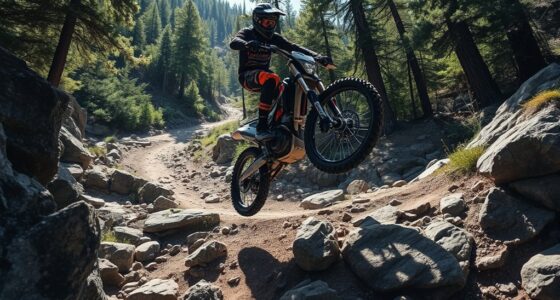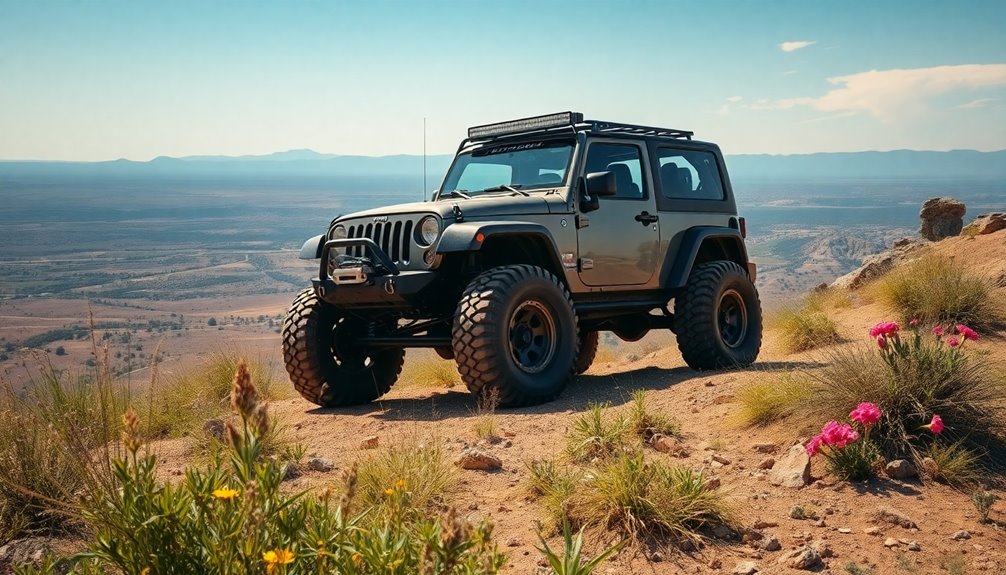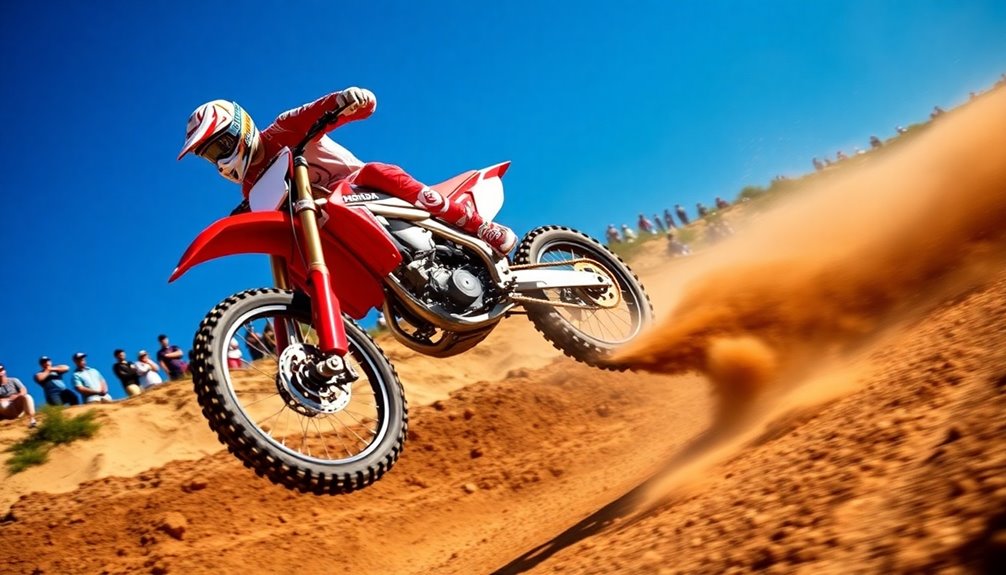To balance speed and line precision on forest single-track, you need to focus on good body positioning, smooth bike handling, and early trail awareness. Scan ahead for features and hazards, choose the widest entry for turns, and use controlled braking and acceleration to maintain momentum. Practicing these techniques helps you stay composed and efficient through technical sections. Keep honing your skills, and you’ll become more confident maneuvering even the trickiest trail segments. Continue exploring the strategies that can elevate your riding experience.
Key Takeaways
- Visualize and plan your line early to maintain control and optimize speed through technical sections.
- Use body positioning and smooth braking to balance momentum, stability, and precise line choice.
- Scan ahead for trail features and hazards to adapt your approach and avoid reactive riding.
- Practice on diverse terrains to enhance adaptability, traction, and overall handling skills.
- Break complex sections into manageable segments for better visualization and consistent line execution.
Understanding the Layout of Forest Single-Track Trails

Understanding the layout of forest single-track trails is essential for traversing them safely and efficiently. As you ride, pay attention to the trail’s features, such as sharp turns, narrow sections, and obstacles like roots or rocks. Notice how the trail twists and where it dips or climbs; this helps you anticipate your next move. Look for trail markers or natural landmarks to keep your orientation. Recognizing different trail sections, like straightaways or technical spots, allows you to plan your speed and line choices accordingly. Being aware of the trail’s flow enables smoother riding and reduces surprises. With a clear understanding of the trail’s layout, you’ll gain confidence and improve your ability to navigate even complex single-track terrain. Incorporating trail features into your awareness can further enhance your riding strategy and safety.
The Importance of Proper Body Position and Bike Handling
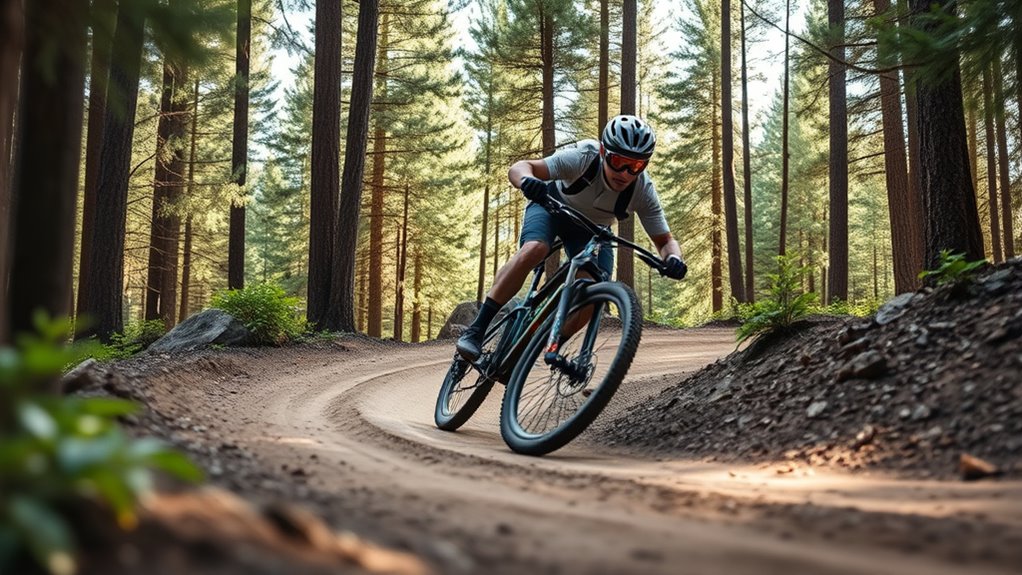
Your body position and bike handling directly impact your control and safety on forest single-tracks. By keeping your body centered and distributing your weight properly, you’ll navigate turns and obstacles more smoothly. Mastering smooth bike movements helps maintain balance and momentum through challenging terrain. Paying attention to your body positioning can significantly improve your riding efficiency and safety.
Centered Body Positioning
Maintaining a centered body position is essential for bike control and stability on single-track trails. It helps you stay balanced, respond quickly to terrain changes, and maintain momentum. To achieve this, keep your hips over the bike’s center, slightly bent at the elbows and knees. This stance allows for better shock absorption and precise handling. Use the table below to understand key body positioning tips:
| Tip | Benefit |
|---|---|
| Keep hips level | Enhances balance and control |
| Slight bend in elbows | Improves shock absorption |
| Relax your grip | Prevents fatigue and improves handling |
| Look ahead | Anticipates trail changes |
| Maintain even weight | Ensures stability and responsiveness |
Additionally, practicing body positioning exercises can help develop muscle memory and improve overall riding skill.
Optimal Weight Distribution
Proper weight distribution is the key to responsive handling and control on single-track trails. When you shift your weight correctly, you enhance traction, stability, and maneuverability. To find the ideal balance:
- Keep your weight centered for stability during straight sections and gentle turns.
- Shift your weight back slightly when climbing to maintain grip on the rear wheel.
- Move your weight forward on descents to prevent the front wheel from lifting.
- Lean into corners with your body and bike, distributing weight evenly to maintain line and speed.
- Paying attention to projector calibration can help you better visualize trail details, making it easier to judge terrain and react appropriately.
Mastering these adjustments keeps your bike responsive and prevents slipping or oversteering. Proper weight distribution allows you to react swiftly to trail changes and maintain control, making your ride smoother and more confident.
Smooth Bike Movements
Achieving smooth bike movements relies heavily on body position and precise bike handling. You want to stay relaxed, with your elbows slightly bent and your weight centered over the bike. Keep your hips loose to absorb shocks and facilitate quick adjustments. When approaching technical sections, shift your body forward or backward to maintain balance and traction. Look ahead, not down, to anticipate obstacles and plan your line. Use subtle movements of your handlebars and body to steer smoothly, avoiding sudden jerks. Proper body position allows your bike to respond naturally to terrain changes, reducing fatigue and improving control. Practice maintaining a fluid rhythm, coordinating your movements with the trail’s flow. Incorporating automation technologies into your riding practice can help you develop consistent techniques and improve overall performance. Mastering these techniques helps you glide through tricky sections with confidence and efficiency.
Techniques for Choosing the Ideal Line Through Twists and Turns
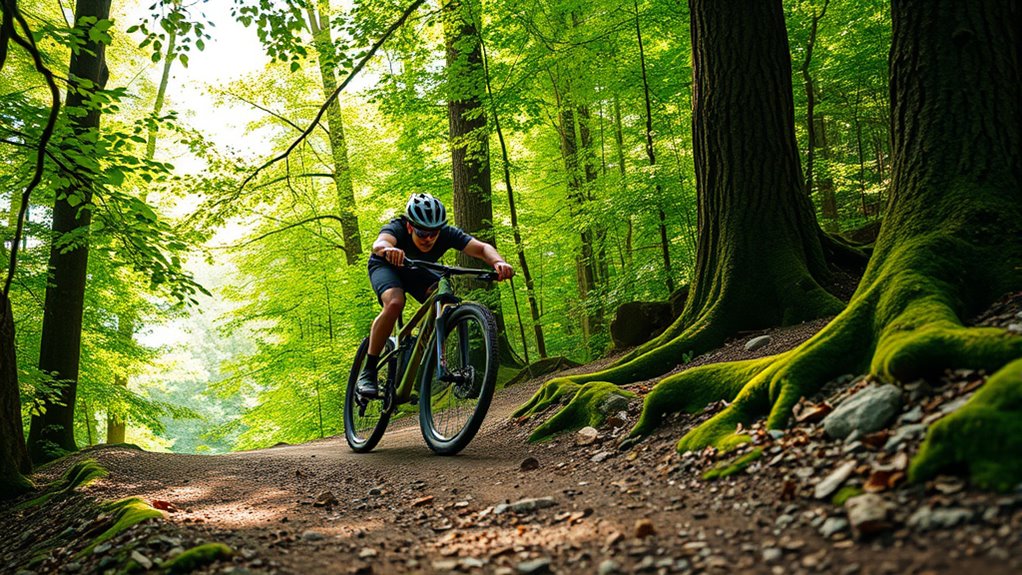
When approaching twists and turns on a forest single-track, selecting the right line can make the difference between a smooth ride and losing momentum. To choose the best path, focus on these techniques:
- Look ahead to identify the turn’s exit point and plan your line early.
- Stay relaxed and keep your weight centered to maintain control.
- Use the widest entry to set up for a clean, tight turn.
- Shift your body slightly inside the turn for better balance and precision.
- Consistently evaluate your line choice to adapt your approach as the trail conditions change.
Strategies for Managing Speed Without Sacrificing Control

Controlling your speed on a forest single-track is essential for staying safe and maintaining flow, especially when maneuvering tricky sections. To do this, focus on smooth, gradual braking before entering turns or technical areas, rather than sudden stops or heavy braking mid-corner. Use your body position to help manage speed—lean slightly back on descents and shift your weight forward on climbs to keep traction. Keep your pedal pressure consistent, avoiding aggressive inputs that can cause loss of control. Practice modulating your speed through gentle throttle adjustments and controlled braking. By staying relaxed and attentive, you can fine-tune your pace to match trail conditions, preserving control without sacrificing momentum. Understanding speed management is crucial for safe and effective riding in challenging terrain. This balance allows you to navigate confidently while maintaining the flow and rhythm of your ride.
Recognizing and Responding to Trail Hazards and Obstacles

To navigate a forest single-track safely, you must stay alert for trail hazards and obstacles that can unexpectedly disrupt your ride. Recognizing these early allows you to react smoothly and maintain control. Keep an eye out for:
- Loose rocks and gravel that can cause slips or skids
- Fallen branches or logs blocking the path
- Sudden changes in trail surface, like mud or roots
- Wildlife or other riders unexpectedly crossing your path
Being attentive to these hazards helps you plan your line and adjust your speed accordingly. When you see an obstacle, slow down, choose a safe route around it, and stay balanced. This awareness keeps you safe and confident, letting you focus on enjoying the ride.
The Role of Braking and Acceleration in Line Precision
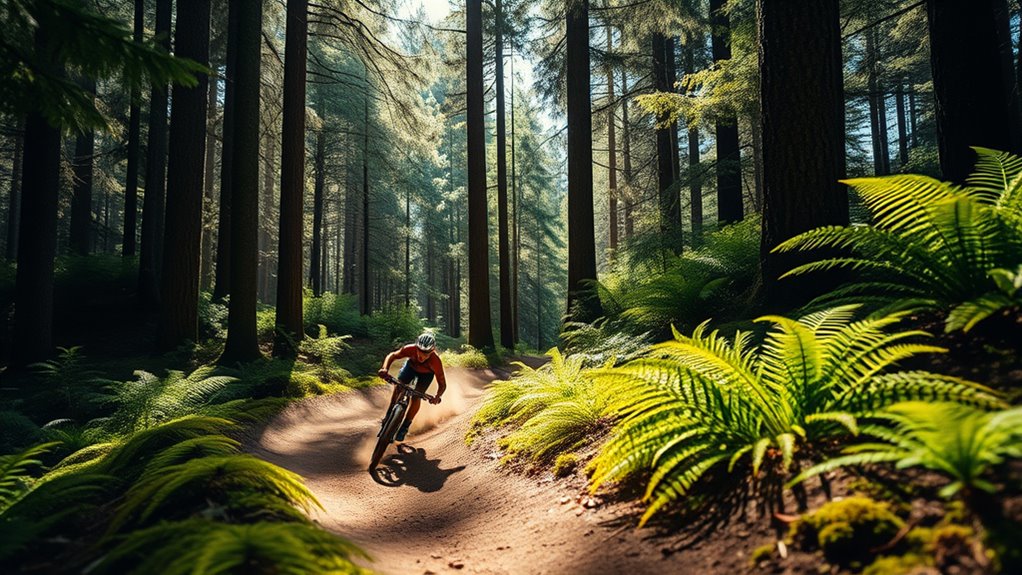
Braking and acceleration are fundamental tools for maintaining line precision on a forest single-track. Proper use of braking allows you to control your speed, helping you stay on the desired line through tight corners and uneven terrain. Light, controlled braking prevents you from overshooting or losing traction, especially on loose or muddy surfaces. Conversely, acceleration helps you regain momentum after obstacles or sharp turns, ensuring you don’t drift off course. Smooth, deliberate shifts between braking and acceleration keep your bike balanced and stable. Timing is vital; braking too early or too late can compromise your line and reduce control. Practicing this coordination allows you to navigate tricky sections confidently, maintaining a precise line without sacrificing speed. Using performance metrics can help you analyze and improve your technique over time. Mastering these techniques is key to an efficient, controlled ride.
Tips for Practicing and Improving Your Line Selection Skills
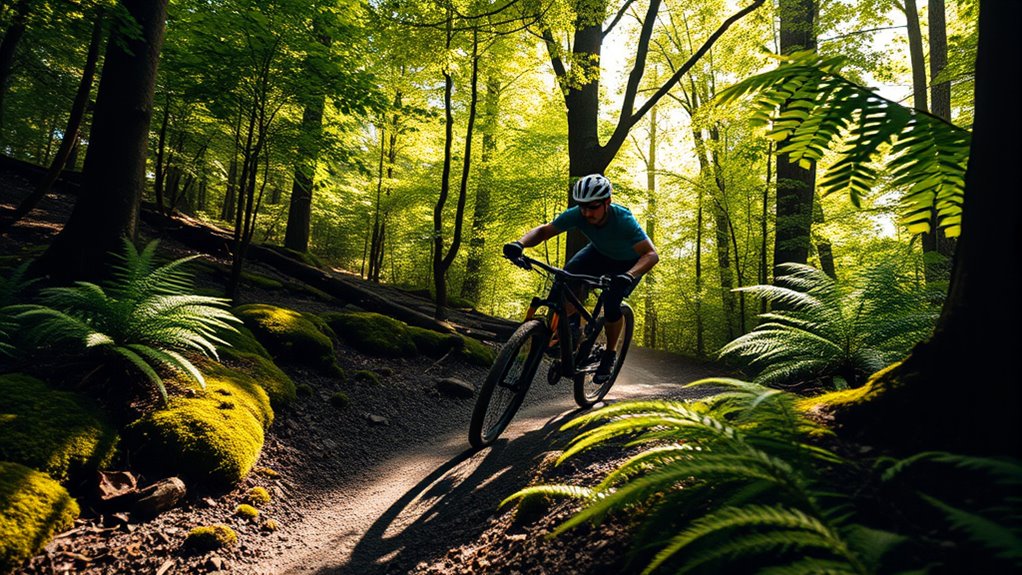
To sharpen your line selection skills, start by visualizing the best possible path through each section before you ride. Practice on different types of terrain to understand how lines change with conditions and obstacles. This approach helps you become more confident and adaptable on every single-track challenge. Participating in virtual hackathons can also inspire new ideas and strategies for tackling complex riding scenarios.
Visualize Optimal Lines
Visualizing the ideal line before you ride can considerably improve your control and confidence on single-track trails. It helps you anticipate turns, obstacles, and braking points, making your ride smoother. To enhance this skill, try these tips:
- Scan ahead to identify the best route early, rather than reacting last minute.
- Mentally picture the perfect line, imagining smooth turns and clear passages.
- Break down complex sections into manageable segments, visualizing each step.
- Use references like natural features or trail markings to guide your visualization and stay on course.
- Incorporate line selection strategies to refine your ability to choose the most efficient path through challenging terrain.
Practicing these steps consistently will sharpen your ability to select and stick to *ideal* lines, boosting both speed and precision on technical terrain.
Practice on Varied Terrain
Practicing your line selection on a variety of terrains is essential to becoming a confident and skilled rider. Different surfaces, such as loose gravel, roots, mud, or rocky sections, challenge your ability to adapt quickly. When you encounter these variations, focus on observing how your bike responds and adjust your approach accordingly. Take opportunities to ride different trail conditions regularly, not just smooth single-track. This exposure helps you develop a better sense of traction, balance, and line choice under diverse circumstances. Embrace each terrain as a learning experience, pushing your limits gradually. Over time, you’ll build intuition for selecting the best line, improving both your speed and precision in unpredictable forest environments.
Frequently Asked Questions
How Does Terrain Type Influence Line Selection on Forest Single-Tracks?
Terrain type directly impacts your line choice on forest single-tracks. On loose or uneven surfaces, you’ll pick wider, more stable lines to maintain control and avoid slipping. When the trail is smooth and firm, you can choose tighter, more direct lines to maximize speed. You need to adapt your line to match terrain conditions, balancing safety and efficiency, so you stay agile and confident through every twist and turn.
What Gear Settings Optimize Balance Between Speed and Control?
Imagine riding a tightrope—your gear is your balancing pole. To optimize speed and control, shift to lower gears for steep climbs and technical sections, giving you more torque and precision. On flat or downhill stretches, upshift for smoother, faster rides. Keep your suspension dialed in for terrain variation, and choose a gear that feels natural, helping you stay fluid and confident without sacrificing momentum or stability.
How Can Weather Conditions Impact Trail Line Choices?
Weather conditions considerably influence your trail line choices. Rain or mud make the terrain slippery, so you should pick a line with better grip and avoid risky sections. Wet leaves, snow, or ice also demand more cautious lines to prevent slipping. You might need to slow down, choose more stable paths, or adjust your line to maintain control and safety. Always adapt your line to match current weather for ideal riding.
Are There Specific Training Drills to Improve Line Accuracy?
You can improve your line accuracy by incorporating specific training drills into your routine. Practice tight turns, focusing on precise bike placement and body positioning. Use cone drills to simulate technical sections, aiming for clean, controlled lines. Incorporate slow-speed drills to enhance control and precision. Consistently challenge yourself with varied terrain to develop adaptability. Over time, these drills will boost your confidence and help you maintain better line control on the trail.
How Do Different Bike Setups Affect Handling on Technical Trails?
Different bike setups considerably impact how you handle technical trails. A bike with a slack head angle and longer wheelbase offers stability at speed, while a steeper angle improves agility for tight turns. Adjusting suspension, tire pressure, and handlebars can enhance control and comfort. Experiment with these configurations to find what feels best for your riding style, helping you navigate tricky sections more confidently and efficiently.
Conclusion
So, after all that talk about balancing speed and precision, it’s funny how the perfect line often feels like luck rather than skill. You’ll learn to read the trail, master your body position, and manage your speed—yet sometimes, the biggest challenge is just trusting your gut. Ironically, the more you try to control every turn, the more unpredictable the trail becomes. But hey, isn’t that what makes mountain biking so addictive?



